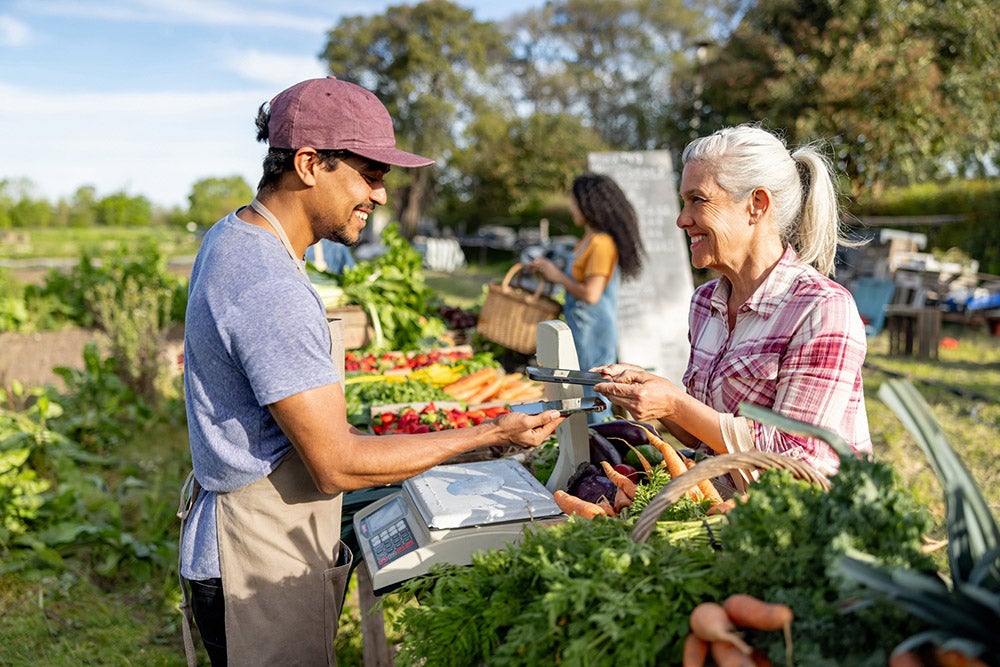Incorporating Fresh, Local Produce into Your Diet through Seasonal Eating
July 24, 2025
Seasonal eating refers to choosing your food and meals based on what foods are in harvest at that time of year. Before modern food preservation and refrigeration, communities ate exclusively local foods that were in season and available. While modern transportation has allowed people to stop eating simply to survive in many parts of the world, it has also led to a decrease in nutrition as foods become available year-round, out of their peak season.
We spoke with Kristina Rivera, MS, RDN, LDN, who is a Clinical Dietician at Saint Joseph Health System, to learn how someone can start incorporating local produce into their diets and why it's so important.
“Seasonal eating is trying to seek or purchase food ingredients that grow in the state you're in or nearby the county you're in. The closer the source of the food that you can get, depending on where you live, the more local it is" says Kristina.
What are the benefits of seasonal eating?
It may seem like seasonal eating wouldn't make a difference. After all, food is food, right? That's actually not true. Incorporating seasonal foods into your diet has many benefits over out-of-season options, including for your health, wallet, and even the environment.
Nutritional advantages
When produce is picked at harvest, they are at their nutritional peak. The longer transportation takes to arrive on your plate, the less nutritional value it will have. Seasonal food is less likely to have been subject to extensive transportation, lengthy storage or artificial harvesting techniques. Most in-season produce is grown in the best conditions, containing the most vitamins, nutrients and antioxidants.
For example, research has shown that broccoli grown in the fall/winter had almost twice the amount of vitamin C as broccoli grown in the spring.
"The nutritional advantages of in-season produce are that it's fresher, and the nutrients that the produce developed are going to be at their peak. The less time they spend on the shelf, the more nutrition you can get" says Ms. Rivera.
Economic advantages
Supporting your local farmer's markets is not only good for your wallet, it helps your community. Typically, produce sold in season is more cost-effective because they aren't being forced to grow out of season. Forcing vegetables to grow out of season requires more electricity, water, and other resources. Growth rate and yield of harvest will be greater, leading to a surplus of seasonal produce and then more competitive pricing. Not to mention the reduced transportation and storage costs.
By purchasing from your local farmers or participating in community-supported agriculture or CSA programs, you're directly contributing to your local economy and making a personal connection with the people who put food on your table.
"A lot of local farmers markets have means to have seasonal produce more accessible to people that don't have as much money. For example, many farmers markets accept EBT.” says Ms. Rivera.
For a directory of farmer’s markets that accept SNAP benefits, click here. For those in the state of IN check out Double Up Indiana for locations and farmer’s markets accepting SNAP benefits.
Environmental advantages
When purchasing seasonal foods, you're positively influencing the environment. It's estimated that transportation accounts for nearly 20% of all CO2 emissions from the global food trade, and almost 40% of emissions generated from fruit and vegetable production comes from transportation.
Because in-season produce usually requires less transportation and storage, the more food that is bought locally, the more impact consumers can have a direct contribution to lowering emissions.
How to shop for seasonal produce
While seasonal shopping has many benefits, it can be daunting to find your local farmer's markets, understand seasonal cycles, and identify seasonal fruits and vegetables. Thankfully, the following resources can make shopping for yourself or your family much easier throughout every season.
- USDA Local Food Directories – Find local farmer's market to support your community's food production.
- Seasonal Food Guide – Learn when your favorite foods are in season anywhere in the United States.
- Purdue FoodLink – Find local farmer's market specifically in Indiana.
- USDA Community Supported Agriculture (CSA) Directory – These programs allow people to purchase directly from farmers, paying upfront for a season of food from that farm.
Community-supported agriculture (CSA) programs
Not many people have heard of CSA programs, but they may be the most direct way to purchase seasonal food and directly support your local farmers.
These programs are subscription-based farm sharing. Farmers ask their members to subscribe and pay upfront before a harvesting season. Members either pick up their shares weekly or have them delivered to their homes.
How to overcome challenges related to seasonal eating
Unfortunately, seasonal eating can be challenging for people who don't have easy access to local produce. For example, it can be difficult for those living in urban areas or food deserts with limited access to fresh produce. However, several solutions can help mitigate these problems:
- Online resources and delivery services: Utilize online platforms that deliver fresh, seasonal produce directly to your doorstep. Certain companies offer subscriptions for weekly or bi-weekly deliveries of seasonal produce. Ask your local farmer if they deliver directly to your door.
- Urban farmers’ markets: Many urban areas have seasonal markets that provide locally grown produce. Certain websites can help locate nearby farmers' markets.
- Community gardens: Participate in or support community garden initiatives. These gardens often operate in urban settings, providing fresh produce to local residents.
For those unfamiliar with cooking seasonal produce, the learning curve can also seem steep. Here are ways to ease into the practice:
- Take advantage of cookbooks and online tutorials that focus on seasonal cooking.
- Attend local or virtual cooking classes that emphasize using seasonal ingredients. These classes often provide hands-on experience and practical tips.
- Start simply by incorporating one or two seasonal ingredients into your existing recipes. This gradual approach can help you become more comfortable with new produce.
- Save time in the kitchen and reduce food waste by washing, prepping, storing, and planning how to use your seasonal produce as soon as you get home from your local grocer or farmer’s market.
While it might seem difficult to get started, you can successfully integrate seasonal eating into your lifestyle, reaping its numerous health, environmental, and economic benefits.
"It's rewarding to develop a relationship with the direct producer of your food. It's cool to go to a farmer and say, 'Hi, how are you?' and get to know the farmer while having that closer relationship to how we get our food" says Ms. Rivera.
Kristina Rivera MS, RDN, LDN, is a Clinical Dietician for Saint Joseph Health System. Alongside becoming a registered dietitian nutritionist, she earned her Master's Degree in Nutrition Education from California State University. She helps individuals achieve healthy lifestyle changes, manage chronic diseases, and enhance personal wellness both one-on-one, and in group settings.
